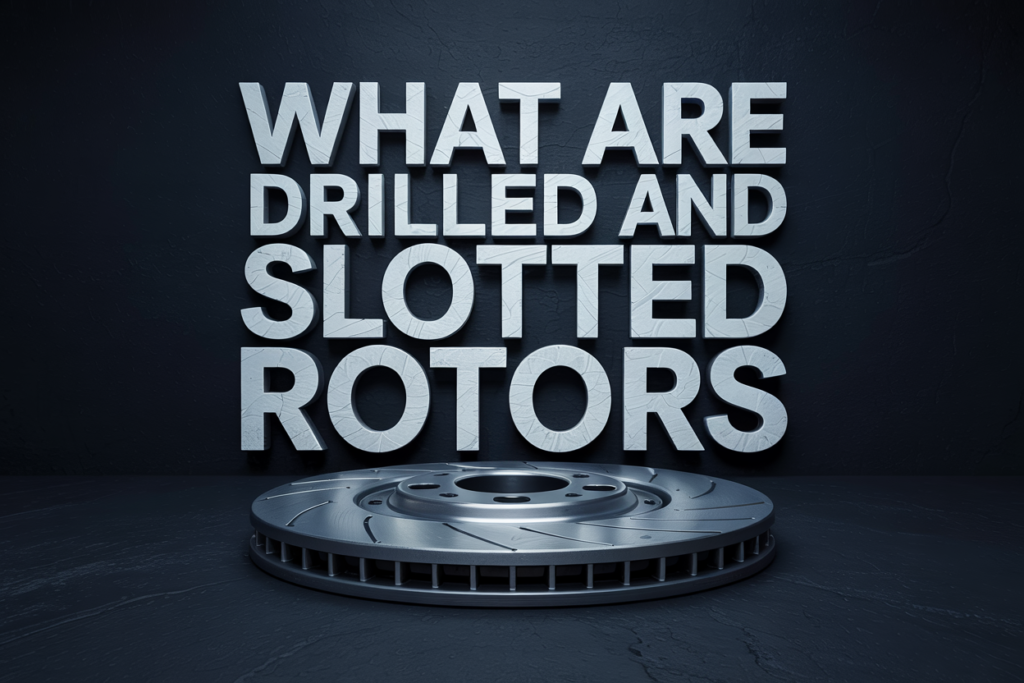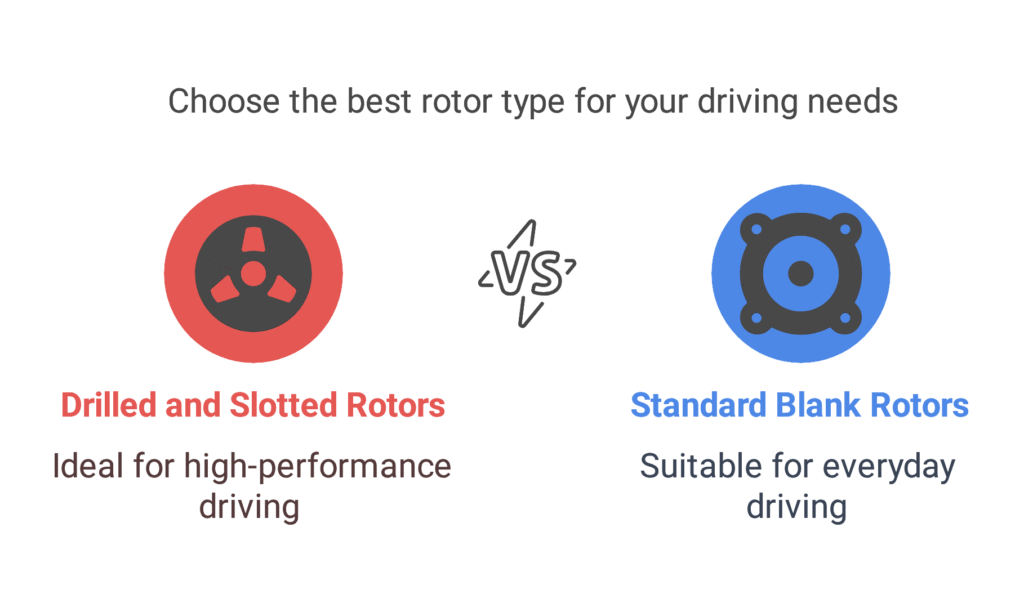Drilled and slotted rotors are often better for high-performance or wet driving conditions, offering improved heat dissipation and braking power—especially under stress. But for everyday driving, the benefits may not outweigh the cost or wear.
If you’ve ever wondered whether drilled and slotted rotors are really worth the upgrade, you’re not alone. Many drivers hear the buzz around “better braking performance” but aren’t sure what it means—or if it’s even necessary for daily use. The truth is, choosing the right rotors depends on how and where you drive. In this article, we’ll break down the pros, cons, and real-world use cases so you can make the smartest choice for your vehicle. Let’s walk through each point clearly—with simple comparisons and practical advice.
Article Summary
What Are Drilled and Slotted Rotors?

Drilled Rotors
Drilled rotors have small, round holes drilled across the surface. These holes let heat, gas, and water escape during braking. When I worked on brake systems in humid areas or regions with lots of rain, drilled rotors helped prevent brake fade due to trapped moisture.
They’re often used in daily drivers or performance cars that don’t need heavy-duty brake pads. One thing I’ve noticed is they do help reduce brake dust buildup. But they may wear down faster and sometimes crack under extreme use.
Slotted Rotors
Slotted rotors feature carved lines or “slots” along the rotor surface. These channels sweep away dirt, water, and brake dust. They’re popular in racing or off-road conditions where brakes get hot quickly. When I installed slotted rotors on a client’s off-road truck, it noticeably improved bite and stopping power on steep descents.
Unlike drilled rotors, slotted versions don’t weaken the rotor structure. They’re stronger, but they tend to wear down brake pads faster—something to keep in mind if you’re on a budget.
Pros and Cons of Drilled and Slotted Rotors
Here’s a quick breakdown of the benefits and drawbacks I’ve found through hands-on use and testing:
| Feature | Drilled Rotors | Slotted Rotors |
| Heat Dissipation | Good | Excellent |
| Water Removal | Very Effective | Good |
| Brake Dust Management | Moderate | High |
| Structural Durability | Lower (can crack under heavy stress) | Higher (stronger under load) |
| Pad Wear | Lower | Higher |
| Ideal For | Wet climates, daily driving | Off-road, towing, performance |
| Cost | Usually cheaper | Slightly more expensive |
From my experience, slotted rotors win when it comes to strength and heavy use. But for most everyday drivers, drilled rotors provide enough performance without overkill.
For more technical info, you can refer to PowerStop’s rotor guide and Brembo’s official FAQ.
When Are Drilled and Slotted Rotors Better?

I recommend drilled and slotted rotors when you need faster cooling and better grip under pressure. This is true if you drive in:
- Mountain areas where long descents can overheat brakes
- Wet or snowy regions where water buildup is a problem
- Track or performance settings with repeated hard stops
- Towing conditions, where your brake system handles extra load
However, if you’re just driving around the city or commuting to work, standard blank rotors may perform just fine and save you money. Over the years, I’ve seen many drivers pay extra for performance rotors they never truly need.
Before buying, ask yourself: Do I often brake hard, tow, or drive in extreme weather? If yes, these rotors could be worth it.
How Do Drilled and Slotted Rotors Compare to Standard Rotors?
When people ask me whether drilled and slotted rotors are “better,” they’re usually comparing them to standard blank rotors—the ones most cars come with from the factory. I’ve tested all three rotor types in real driving conditions, from mountain highways to urban stop-and-go traffic.
Here’s a direct comparison table based on my hands-on experience and real-world usage:
| Feature | Standard (Blank) Rotors | Drilled Rotors | Slotted Rotors |
| Brake Cooling | Average | Good | Excellent |
| Performance Under Stress | Moderate | Improved | Best |
| Noise Level | Very Low | Slightly Noisy | Often Noisy |
| Rotor Lifespan | Long | Shorter (may crack) | Medium |
| Pad Lifespan | Long | Medium | Shorter |
| Ideal Use | Daily commuting | Wet, light performance driving | Racing, towing, off-road |
| Cost | Lowest | Moderate | High |
I usually suggest standard rotors for casual drivers. But if you drive fast, haul loads, or go off-road, drilled or slotted rotors give you a serious edge. You can also read this brake rotor guide from Advance Auto Parts for a deeper dive.
My Personal Recommendation Based on Driving Style
After more than a decade working with brake systems and testing dozens of setups, here’s how I recommend choosing between rotor types:
Daily Commuters and City Drivers
If you drive mostly in light traffic or short distances, standard rotors are perfect. They’re quiet, affordable, and last a long time. I’ve used blank rotors on my personal sedan for over 40,000 miles with no issues.
Performance and Sports Car Owners
If you drive fast or brake hard—whether on tracks or twisty roads—drilled and slotted rotors offer better cooling and fade resistance. I recommend these if your car has high horsepower or sees frequent spirited driving.
Truck Owners, Towing, and Off-Roading
If you tow trailers or go off-road, I suggest slotted rotors. They resist heat and dust buildup better than other options. I once upgraded a client’s pickup with heavy-duty slotted rotors before a cross-country RV haul—and they held up beautifully in the Rockies.
It’s important to match your rotor type to your driving needs. Overbuying rotors for light driving just wastes money.
Do Drilled and Slotted Rotors Last Longer?
In most cases, they don’t. In fact, drilled rotors may wear out faster due to the weakened structure caused by the holes. I’ve seen them crack under repeated heat cycles—especially on track cars or in hot climates.
Slotted rotors, on the other hand, last a bit longer than drilled ones but tend to wear down pads quicker. This is because the slots continuously scrape the surface of the pads to keep them clean. It improves performance but reduces lifespan.
If you’re looking for long rotor life, blank rotors are still the top choice. They don’t have any cuts or holes, which means less stress and smoother wear.
According to Raybestos, rotor material, vehicle type, and driving style all impact how long rotors last. In my own experience, blank rotors last up to 60,000 miles, while drilled or slotted ones often need replacement around 30,000–40,000 miles depending on use.
So while drilled and slotted rotors offer better performance, they aren’t a long-term solution for everyone. Always weigh performance gains against cost and maintenance.
Can You Use Drilled and Slotted Rotors for Daily Driving?
Yes, you can use drilled and slotted rotors on daily drivers, but whether you should depends on your specific driving needs. I’ve installed them on commuter vehicles before—especially in rainy or hilly areas—and they work great. They handle heat better and offer a firmer pedal feel when braking repeatedly in traffic.
That said, most daily drivers don’t need high-performance rotors. If you’re not towing, racing, or descending mountain passes daily, they might not be worth the added cost and faster pad wear. For example, when I upgraded my daily-use Honda Civic with drilled and slotted rotors, braking improved slightly, but the pads wore out about 30% faster.
If you’re unsure, check your manufacturer’s brake recommendations and ask your mechanic. Or visit NAPA Auto Parts to compare factory and performance rotor specs by model.
Are Drilled and Slotted Rotors Worth It?
In my honest experience, drilled and slotted rotors are worth it if you need better performance—not just because they look cool. Here’s a quick breakdown based on driving needs and value:
| Driving Need | Are They Worth It? | Why / Why Not |
| Daily commuting (flat areas) | ❌ No | Extra cost, little benefit |
| Daily commuting (hills/rain) | ✅ Sometimes | Better cooling and water drainage |
| Towing and hauling | ✅ Yes | Stronger bite, less fade under heavy load |
| Racing or track use | ✅ Yes | High heat resistance and faster pad cleaning |
| Budget-conscious maintenance | ❌ No | Shorter pad life, higher upfront cost |
So for regular street use, stick to blanks unless you’re dealing with demanding conditions. But for spirited driving or rough terrain, I recommend performance rotors every time.
For deeper insights, you can also read CarParts.com’s performance brake rotor guide.
Final Verdict
If your current brakes work fine for your routine driving, you don’t need to upgrade. But if you regularly face long hills, heavy loads, or wet roads, then drilled and slotted rotors may be a smart move.
I always tell my clients: The best brake upgrade is one that fits your real-world needs—not just your wish list. I’ve seen too many people waste money on parts they didn’t actually benefit from.
So ask yourself:
- Do I drive aggressively or carry extra weight?
- Do I want better brake feel and heat handling?
- Am I willing to trade pad lifespan for better performance?
If your answer is yes, I say go for it. Just be sure to pair them with quality brake pads and follow your vehicle’s torque specs during installation. Your brakes are only as strong as the system around them.